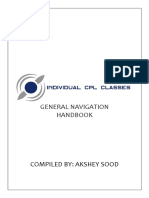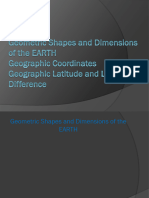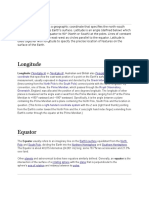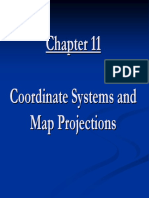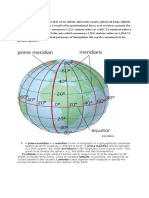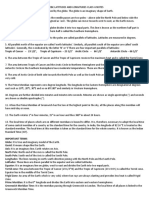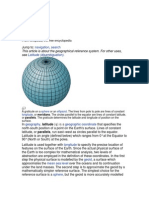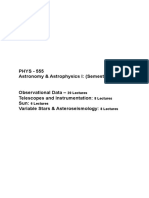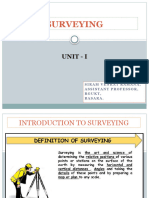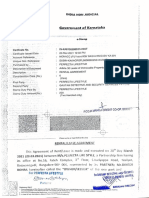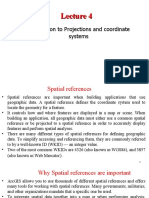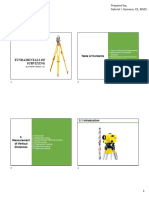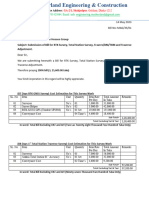Earth Basic Magnetism SPL
Earth Basic Magnetism SPL
Uploaded by
ROHIT REDDYCopyright:
Available Formats
Earth Basic Magnetism SPL
Earth Basic Magnetism SPL
Uploaded by
ROHIT REDDYOriginal Title
Copyright
Available Formats
Share this document
Did you find this document useful?
Is this content inappropriate?
Copyright:
Available Formats
Earth Basic Magnetism SPL
Earth Basic Magnetism SPL
Uploaded by
ROHIT REDDYCopyright:
Available Formats
The Shape of the EARTH
1. Commonly described as an oblate spheroid, that is, a sphere
which is slightly flattened at its poles.
2. The flattening is called compression and in the case of the Earth
is approximately 0.3% (1/300th).
3. The Earth’s polar diameter is 27 Statute miles (or 23 nautical
miles or 43 km) less than its equatorial diameter.
4. Shape of the earth :- Geoid
5. ICAO has adopted world Geodetic System standard 1984.( WGS
84 )
Reciprocal directions :- The direction which is 180° opposite to the direction given. 060 (T) +180= 240
(T)
Position On the Earth /Position Reference System
1. Position Reference System which defines position accurately and unambiguously on the
Earth’s surface.
2. On a plane surface (such as graph paper), position can be defined accurately and
unambiguously using Cartesian co-ordinates ±x and ±y from 2 mutually perpendicular axes
3. The Cartesian system works well on a flat surface but must be modified to work on a
spherical surface, i.e. the Earth
4. The linear co-ordinates x and y are replaced by angular coordinates known as Longitude
and Latitude.
CIRCLES ON THE EARTH
Great Circle
1. A circle on the surface of the Earth whose centre and radius are those of the Earth itself is
called a Great Circle.
2. It is called ‘great’ because a disc cut through the Earth in the plane of the Great Circle
would have the largest area that can be achieved.
3. The shortest distance between two points on the Earth’s surface is the shorter arc of the
Great Circle joining the two points.
THE EQATOR
1. The Great Circle whose plane is at 90° to the axis of rotation of the Earth (the polar axis) is
called the Equator.
2. It lies in an East-West direction and divides the Earth equally into two hemispheres.
3. Equator is the datum for defining Latitude and is the equivalent of the X axis of the
Cartesian system.
The Meridians
1. Meridians are semi-Great Circles joining the North and South poles.
2. All meridians indicate True North-South direction.
3. Every Great Circle passing through the poles forms a meridian
and its Anti-meridian.
4. The meridians cross the Equator at 90°.
The Prime (or Greenwich) Meridian
1. The meridian passing through Greenwich is known the Prime
Meridian .
2. The Prime Meridian is the datum for defining Longitude and is
the equivalent of the Y axis of the Cartesian system.
Small Circle A circle on the surface of the Earth whose centre and radius are not those of the
Earth is called a Small Circle.
Parallels of Latitude
1. The parallels of latitude are small circles on the surface of the
Earth whose planes are parallel to the Equator.
2. They lie in an East-West direction.
3. Their function is to indicate position North or South of the
Equator.
GRATICULE
1. The network formed on a map or the surface of a globe
by the Prime Meridian, the meridians, the Equator and
the parallels of latitude is called the Graticule.
Earth Magnetism
The North and South magnetic poles are not exactly opposite each
other on the Earth. In effect, it is like a bent bar magnet.
MAGNETIC NORTH
1. Magnetic North is the horizontal direction indicated by a freely
suspended magnet influenced only by the Earth’s magnetic field.
2. This direction is sometimes referred to as the ‘magnetic meridian’
at that point.
MAGNETIC DIRECTION
Magnetic Direction is measured from Magnetic North clockwise through 360°, and is suffixed
by the letter ‘M’, e.g. 043(M) and 270(M).
VARIATION
1. Variation is the angular difference between the directions of True and Magnetic North at
any point.
2. Variation is the angle between True and Magnetic North and is measured in degrees East
or West from True North.
3. Isogonal :- A line on the surface of the Earth joining points of equal magnetic variation.
4. Agonic line :- It is the line connecting points North & South poles of Zero variation.
DEVIATION 1. There is a correction to be applied. This is for the difference between Magnetic North
and the direction that a compass needle points.
You might also like
- Navigation Chapter-1: Direction, Latitude and LongitudeDocument76 pagesNavigation Chapter-1: Direction, Latitude and LongitudeAnusher Ansari100% (1)
- Assignment - 1Document21 pagesAssignment - 1shoyeb ahmedNo ratings yet
- General Navigation Handbook: Compiled By: Akshey SoodDocument59 pagesGeneral Navigation Handbook: Compiled By: Akshey SoodManas Batra100% (2)
- ATPL VivaDocument71 pagesATPL Vivacarltonfenandes100% (1)
- Navigation Basics: Fundamental Concepts in Aeronautical NavigationDocument15 pagesNavigation Basics: Fundamental Concepts in Aeronautical NavigationRichard Pedraja100% (3)
- NavigationDocument13 pagesNavigationSahilNo ratings yet
- Chart WorkDocument485 pagesChart WorkMika Marielle TrincheraNo ratings yet
- Navigation IDocument29 pagesNavigation Imohamed100% (1)
- Polaris Fun 1 MainDocument20 pagesPolaris Fun 1 MainJayesh Solaskar100% (1)
- Social Note (2) For Grade 7Document3 pagesSocial Note (2) For Grade 7Melkamu YigzawNo ratings yet
- DR & Maps & Charts CombineDocument118 pagesDR & Maps & Charts Combinefalcon21152115100% (1)
- 1 - 2 Navigation - Lec1 - 2Document23 pages1 - 2 Navigation - Lec1 - 2Дмитрий БарановNo ratings yet
- A Cartographic Map Projection Is A Systematic TransformationDocument34 pagesA Cartographic Map Projection Is A Systematic TransformationShamanth KumarNo ratings yet
- Geog Ch. 1 SummaryDocument7 pagesGeog Ch. 1 SummaryScion McKinleyNo ratings yet
- IAFS - Basic Aerial NavigationDocument27 pagesIAFS - Basic Aerial Navigationioannaknt622No ratings yet
- Latitude: Longitude (Document2 pagesLatitude: Longitude (ailenette.caguisaNo ratings yet
- Bearings-Designate The Direction of A Line by An Angle andDocument5 pagesBearings-Designate The Direction of A Line by An Angle andJohn Paul CuaderoNo ratings yet
- Cartography Unit 3: Basic Geodesy Flashcards - QuizletDocument4 pagesCartography Unit 3: Basic Geodesy Flashcards - QuizletTJ CabatinganNo ratings yet
- NIT Planet Arth: Teacher: Begoña CristellysDocument35 pagesNIT Planet Arth: Teacher: Begoña Cristellysbego docencia100% (1)
- LatitudeDocument16 pagesLatitudealysonmicheaalaNo ratings yet
- Unit 1Document8 pagesUnit 1SahilNo ratings yet
- Chapter3 PDFDocument9 pagesChapter3 PDFAdithyan GowthamNo ratings yet
- Unit 1 The Earth: StructureDocument8 pagesUnit 1 The Earth: StructureJoseph JeganNo ratings yet
- NavigationDocument3 pagesNavigationShashikaNo ratings yet
- Geog CH 2Document8 pagesGeog CH 2himanshukumar29018No ratings yet
- Gnav TheoryDocument9 pagesGnav TheoryMNo ratings yet
- Lec 6Document44 pagesLec 6SUHAYB 96No ratings yet
- Coordinate Systems and Map ProjectionsDocument38 pagesCoordinate Systems and Map ProjectionsdavidNo ratings yet
- The Earth:: 1. A Prime Meridian Is A Meridian (A Line of Longitude) in A Geographical CoordinateDocument3 pagesThe Earth:: 1. A Prime Meridian Is A Meridian (A Line of Longitude) in A Geographical CoordinateKarl KiwisNo ratings yet
- Globe Latitudes and Longitudes Class 6 NotesDocument1 pageGlobe Latitudes and Longitudes Class 6 NotesKalai Selvi MohanNo ratings yet
- Latitude: Navigation SearchDocument20 pagesLatitude: Navigation SearchEduciti MumbaiNo ratings yet
- Solar System and Solar Electricity: Subject Code: EC 38106Document94 pagesSolar System and Solar Electricity: Subject Code: EC 38106Raj TalrejaNo ratings yet
- Navigation... : Longitude and LatitudeDocument16 pagesNavigation... : Longitude and LatitudeSv. Ante100% (1)
- Satcom My PresentationDocument84 pagesSatcom My PresentationSachinSachdevaNo ratings yet
- 75 days NCERT Chapter 2.Document33 pages75 days NCERT Chapter 2.mushu8769No ratings yet
- Unit 1. The Earth PlanetDocument13 pagesUnit 1. The Earth PlanetGRISEL PULIDO GARCÍANo ratings yet
- Lectures 1-40Document411 pagesLectures 1-40Rahul SharmaNo ratings yet
- Principles of NavigationDocument58 pagesPrinciples of NavigationNguyễn Thao80% (5)
- Satellite Communication Lecture-2&3: Dr. Shahab Ahmad NiaziDocument72 pagesSatellite Communication Lecture-2&3: Dr. Shahab Ahmad Niazishahabniazi100% (3)
- Unit-1 Lecture On Solar GeometryDocument35 pagesUnit-1 Lecture On Solar Geometryguptaraj07rgNo ratings yet
- Earth Geometry.Document69 pagesEarth Geometry.Kennedy Mwenya75% (4)
- DT 14 - Air NavigationDocument16 pagesDT 14 - Air NavigationMarcelo MartinsNo ratings yet
- Cel. Nav TheoryDocument27 pagesCel. Nav TheoryRahul DevnathNo ratings yet
- Earth MagnetismDocument24 pagesEarth MagnetismAyush Srivastava75% (4)
- Field Geology (Lec.2)Document9 pagesField Geology (Lec.2)cm4pt45hkvNo ratings yet
- Physics Project. FinalDocument22 pagesPhysics Project. Finalforchat759No ratings yet
- Geography Class 6th NcertDocument21 pagesGeography Class 6th NcertPrachi ChoudharyNo ratings yet
- What Are Longitudes and LatitudesDocument2 pagesWhat Are Longitudes and LatitudesClaudene GellaNo ratings yet
- (B) - Location, Distance, and Direction On MapsDocument12 pages(B) - Location, Distance, and Direction On MapsprasadNo ratings yet
- Globe Latitudes and LongitudesLPsDocument7 pagesGlobe Latitudes and LongitudesLPsbountybackyardNo ratings yet
- Latitude and Longitudes in GeodesyDocument6 pagesLatitude and Longitudes in GeodesyAbdo SaeedNo ratings yet
- Chapter 01 - The Form of The EarthDocument7 pagesChapter 01 - The Form of The EarthIludiran Kola100% (2)
- Geographic Coordinate: Latitude - Is ADocument2 pagesGeographic Coordinate: Latitude - Is AMathew Beniga GacoNo ratings yet
- 1priciples of NavigationDocument71 pages1priciples of Navigationjaishankar akshay0% (1)
- 2-Satellite - Systems 2 - Orbits IIIDocument42 pages2-Satellite - Systems 2 - Orbits IIIمهيمن الابراهيميNo ratings yet
- Where did That Number Come From?: Chronological Histories and Derivations of Numbers Important in ScienceFrom EverandWhere did That Number Come From?: Chronological Histories and Derivations of Numbers Important in ScienceNo ratings yet
- Encyclopaedia Britannica, 11th Edition, Volume 17, Slice 7 "Mars" to "Matteawan"From EverandEncyclopaedia Britannica, 11th Edition, Volume 17, Slice 7 "Mars" to "Matteawan"No ratings yet
- NTI Pinaglabanan TCTDocument9 pagesNTI Pinaglabanan TCTFrederick Bravo NaranjaNo ratings yet
- Urban Legal Cadaster StandardDocument41 pagesUrban Legal Cadaster StandardDesu GashuNo ratings yet
- Chart Work - OowDocument159 pagesChart Work - OowAboody AL-ghamdy100% (1)
- Surveying Unit-1Document64 pagesSurveying Unit-1deshabodanaveenNo ratings yet
- Garmin Icao Flight Plan InformationDocument4 pagesGarmin Icao Flight Plan InformationIury SantanaNo ratings yet
- 27 WKNM 22Document129 pages27 WKNM 22Yahia EltunsyNo ratings yet
- Review Module 12 Surveying 1 Part 2Document2 pagesReview Module 12 Surveying 1 Part 2Ice DelevingneNo ratings yet
- Basics On Marine NavigationDocument5 pagesBasics On Marine NavigationYowjess100% (1)
- Report On The Landlord and Tenant Bill 2021Document72 pagesReport On The Landlord and Tenant Bill 2021jadwongscribdNo ratings yet
- Kurs Passage Planning With ECDISDocument49 pagesKurs Passage Planning With ECDISnikoNo ratings yet
- Gen NavDocument17 pagesGen Navsneha jauhariNo ratings yet
- YEATON Navigation Standards 2021Document42 pagesYEATON Navigation Standards 2021muhamed.louiNo ratings yet
- Plazzo Mall Rental AgreementDocument3 pagesPlazzo Mall Rental AgreementATGS GNo ratings yet
- Lecture 4Document59 pagesLecture 4Qateel JuttNo ratings yet
- Porur - Groud FloorDocument3 pagesPorur - Groud FloorparthibanNo ratings yet
- Luzon National High School: Luzon, Governor Generoso, Davao OrientalDocument2 pagesLuzon National High School: Luzon, Governor Generoso, Davao OrientalMaria GudesNo ratings yet
- OS Map LegendDocument6 pagesOS Map LegendfionabijuNo ratings yet
- Celestial NavigationDocument112 pagesCelestial NavigationCan T. ErbayNo ratings yet
- Surveying II O18 R15 3012Document3 pagesSurveying II O18 R15 3012Sufaira ShahadiyaNo ratings yet
- Contoh Report Post ProcessingDocument2 pagesContoh Report Post Processingr0y51No ratings yet
- Baseline Processing Report-NEWDocument63 pagesBaseline Processing Report-NEWAl IjupNo ratings yet
- L4 CH Lat, DLat, MlatDocument12 pagesL4 CH Lat, DLat, MlatMoamen AbdienNo ratings yet
- Fundamentals of Surveying - Chapter 3Document13 pagesFundamentals of Surveying - Chapter 3luizNo ratings yet
- Bill For RTK Survey and Total Station Survey and TraversDocument2 pagesBill For RTK Survey and Total Station Survey and TraverswNo ratings yet
- Lot Plan-1Document1 pageLot Plan-1johnpaul mosuelaNo ratings yet
- Sps Bloqsi Wyali, Wyalarineba Saproeqto 01.05.2024Document1 pageSps Bloqsi Wyali, Wyalarineba Saproeqto 01.05.2024tornikejishkariani21No ratings yet
- 20th Meridian East: From Pole To PoleDocument3 pages20th Meridian East: From Pole To PoleKarl GustavNo ratings yet
- Reply To Denr MemoDocument11 pagesReply To Denr MemoFrancis AboyNo ratings yet
- APRSL2021 Vergonville - May18Document10 pagesAPRSL2021 Vergonville - May18Maureen ban-egNo ratings yet
- St. Croix County Property Transfers For Dec. 28, 2020-Jan. 3, 2021Document31 pagesSt. Croix County Property Transfers For Dec. 28, 2020-Jan. 3, 2021Michael BrunNo ratings yet


